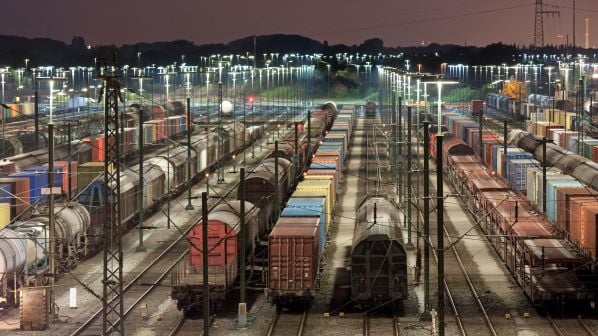THE Red Sea shipping crisis and the mass re-routing of cargo ships around the Cape of Good Hope beginning in late December has added 10-20 days to sailings from Chinese to European ports.
The delays have prompted shipping companies to look to rail as an alternative. Yet various factors are preventing rail freight from seizing this golden opportunity to grow market share from its current modest 3% and to convince shippers of rail’s longer-term merits for moving certain goods.
After launching in 2013, the China-Europe Railway Express (CRE) network steadily grew to 73 routes, connecting more than 50 cities in mainland China with 217 cities in 25 countries in Europe. China Railway and the Chinese government regularly cite CRE as a successful result of the country’s flagship Belt and Road Initiative: more than 80,000 CRE trains carrying more than 7.6 million TEU have made the transcontinental journey. Shippers value the speed of the route, in particular for high-value goods, moving more than 50,000 different products in the last 10 years.
However, Russia’s invasion of Ukraine in February 2022 changed the picture.
The increased risk of moving goods through Russia has forced shippers to look at other options.
The most popular route for this traffic has been the northern corridor via Russia’s Trans-Siberian railway to Belarus and Poland. While official figures from China Railway state that traffic is continuing to grow - including by 27% in the first seven months of 2023 - according to data released by Eurasian Rail Alliance Index, the volume of TEU reaching Europe fell 48% year-on-year between January and August 2023 to 149,360 TEU, just 11.8% of the total carried on the route. The number of European destinations has also fallen to just five. CRE has in effect become the China-Russia Railway Express.
The increased risk of moving goods through Russia has forced shippers to look at other options. Rather than turn away from rail completely, many looked to the middle corridor through western China to Kazakhstan, the Caspian Sea and the southern Caucasus to Europe as an alternative.
Volumes increased by 77% year-on-year in the first half of 2023 to 1.3 million tonnes. The signs are that this momentum will continue. However, shipments on this route can take up to 60 days, all but ending rail’s speed advantage over the shipping lines. And while the gap has closed, the middle corridor’s volumes are still just 18% of those carried on the northern corridor where journeys to Europe can now take just 12 days following the fall in traffic.
Growing demand on the middle corridor is prompting action. Kazakhstan is working hard to improve capacity, launching a project to build a third line to China and a new 152km cross-border link from Darbaza to Maktaaral in Uzbekistan in the last few months. Europe looks likely to provide funding to support middle corridor development as it seeks greater energy security. But these new railways and upgrades are still years in the making. Even further off, given the current war in the Middle East, is the plan launched at the G20 summit last year for a new trans-Arabian freight corridor from India via the Arabian Peninsula to Jordan, Israel and the Mediterranean.
Europe in flux
The situation in Europe itself is also far from conducive for growing rail freight traffic.
In a lengthy statement released in December entitled “The shift to rail is faltering,” Swiss operator BLS Cargo pointed out that rail’s share of intermodal and conventional freight traffic had fallen by 10-15% year-on-year in 2023.
Trans-Alpine freight flows have also been hit by the simultaneous closure of the Gotthard Base Tunnel and Fréjus Tunnel in the second half of 2023. The current poor condition and unreliability of the German network is likewise a major source of frustration for rail freight companies, which are struggling to adapt to changes in maritime flows to European ports.
“On certain routes north of Switzerland, more than half of freight trains are running more than six hours late,” BLS says. “[This] year further major infrastructure work is planned on the northern approach and routes will even be closed to rail freight traffic for months without the necessary diversionary capacity being made available. This leads to planned and also short-term cancellations of freight trains, which means a high financial burden for the rail transport companies.”
The situation was compounded in January by a series of strikes in Germany, which have crippled traffic on the network. Mr Clemens Först, CEO of Austria’s Rail Cargo Group, took to social media to vent his frustration, describing the strikes as “a serious threat to sustainable logistics” and bemoaning the impact on rail’s long-term reputation and ability to lure back shippers that have switched to road.
On current form, the target to increase rail freight traffic by 50% by the end of this decade, as enshrined in the European Union’s (EU) Sustainable and Smart Mobility Strategy, look increasingly unrealistic. The situation can still be turned around and BLS suggests immediate action in three areas:
- coordination of infrastructure work and compensation for operators - work interrupting rail traffic should only take place if there are diversion options for 80% of freight volumes. It says improved international cooperation between infrastructure managers is essential.
- improve and increase capacity of passing loops and yards to support short-term freight paths, and
- stabilisation and reduction of track access charges.
Further improvements envisaged under proposed revisions to the regulation on the use of rail infrastructure capacity, currently being discussed in the European Parliament, also offer hope. The proposed regulation promises to optimise capacity allocation and potentially increase overall capacity by 4%, making it easier to obtain paths at short notice, and ease cross-border flows which account for 50% of freight traffic.
Encouragingly, there is optimism within the rail freight industry that passage of the legislation will happen before the European elections in June. Success here would offer some light in what is proving to be a dark time for the sector.

